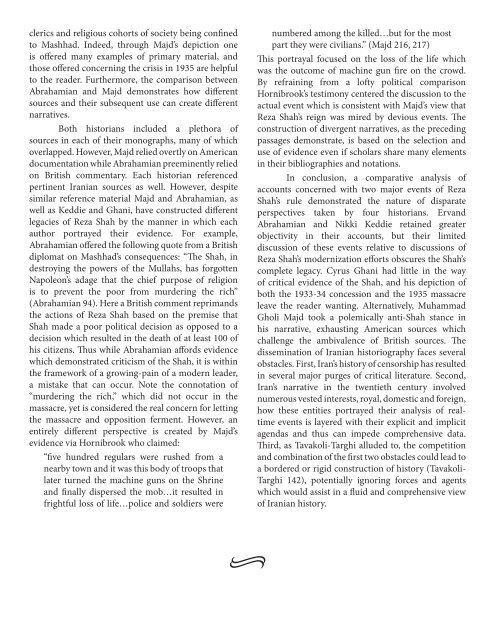Create successful ePaper yourself
Turn your PDF publications into a flip-book with our unique Google optimized e-Paper software.
clerics and religious cohorts of society being confined<br />
to Mashhad. Indeed, through Majd’s depiction one<br />
is offered many examples of primary material, and<br />
those offered concerning the crisis in 1935 are helpful<br />
to the reader. Furthermore, the comparison between<br />
Abrahamian and Majd demonstrates how different<br />
sources and their subsequent use can create different<br />
narratives.<br />
Both historians included a plethora of<br />
sources in each of their monographs, many of which<br />
overlapped. However, Majd relied overtly on American<br />
documentation while Abrahamian preeminently relied<br />
on British commentary. Each historian referenced<br />
pertinent Iranian sources as well. However, despite<br />
similar reference material Majd and Abrahamian, as<br />
well as Keddie and Ghani, have constructed different<br />
legacies of Reza Shah by the manner in which each<br />
author portrayed their evidence. For example,<br />
Abrahamian offered the following quote from a British<br />
diplomat on Mashhad’s consequences: “The Shah, in<br />
destroying the powers of the Mullahs, has forgotten<br />
Napoleon’s adage that the chief purpose of religion<br />
is to prevent the poor from murdering the rich”<br />
(Abrahamian 94). Here a British comment reprimands<br />
the actions of Reza Shah based on the premise that<br />
Shah made a poor political decision as opposed to a<br />
decision which resulted in the death of at least 100 of<br />
his citizens. Thus while Abrahamian affords evidence<br />
which demonstrated criticism of the Shah, it is within<br />
the framework of a growing-pain of a modern leader,<br />
a mistake that can occur. Note the connotation of<br />
“murdering the rich,” which did not occur in the<br />
massacre, yet is considered the real concern for letting<br />
the massacre and opposition ferment. However, an<br />
entirely different perspective is created by Majd’s<br />
evidence via Hornibrook who claimed:<br />
“five hundred regulars were rushed from a<br />
nearby town and it was this body of troops that<br />
later turned the machine guns on the Shrine<br />
and finally dispersed the mob…it resulted in<br />
frightful loss of life…police and soldiers were<br />
numbered among the killed…but for the most<br />
part they were civilians.” (Majd 216, 217)<br />
This portrayal focused on the loss of the life which<br />
was the outcome of machine gun fire on the crowd.<br />
By refraining from a lofty political comparison<br />
Hornibrook’s testimony centered the discussion to the<br />
actual event which is consistent with Majd’s view that<br />
Reza Shah’s reign was mired by devious events. The<br />
construction of divergent narratives, as the preceding<br />
passages demonstrate, is based on the selection and<br />
use of evidence even if scholars share many elements<br />
in their bibliographies and notations.<br />
In conclusion, a comparative analysis of<br />
accounts concerned with two major events of Reza<br />
Shah’s rule demonstrated the nature of disparate<br />
perspectives taken by four historians. Ervand<br />
Abrahamian and Nikki Keddie retained greater<br />
objectivity in their accounts, but their limited<br />
discussion of these events relative to discussions of<br />
Reza Shah’s modernization efforts obscures the Shah’s<br />
complete legacy. Cyrus Ghani had little in the way<br />
of critical evidence of the Shah, and his depiction of<br />
both the 1933-34 concession and the 1935 massacre<br />
leave the reader wanting. Alternatively, Muhammad<br />
Gholi Majd took a polemically anti-Shah stance in<br />
his narrative, exhausting American sources which<br />
challenge the ambivalence of British sources. The<br />
dissemination of Iranian historiography faces several<br />
obstacles. First, Iran’s history of censorship has resulted<br />
in several major purges of critical literature. Second,<br />
Iran’s narrative in the twentieth century involved<br />
numerous vested interests, royal, domestic and foreign,<br />
how these entities portrayed their analysis of realtime<br />
events is layered with their explicit and implicit<br />
agendas and thus can impede comprehensive data.<br />
Third, as Tavakoli-Targhi alluded to, the competition<br />
and combination of the first two obstacles could lead to<br />
a bordered or rigid construction of history (Tavakoli-<br />
Targhi 142), potentially ignoring forces and agents<br />
which would assist in a fluid and comprehensive view<br />
of Iranian history.<br />
•


